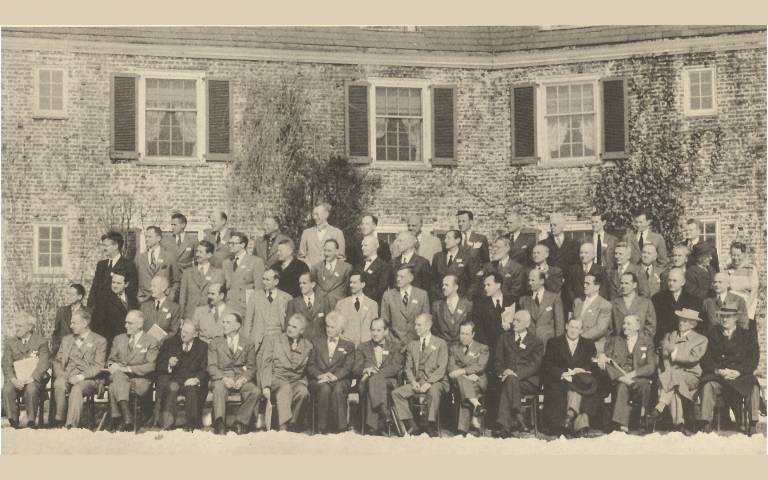 Research
Research

Subject
The Architect-Teacher’s Role in Formulating Architectural Pedagogy in China before 1952: The Examples of Huang Zuoshen and Liang Sicheng
First and second supervisors
Abstract
This thesis examines China’s early modern architectural pedagogy before the 1952 restructuring of higher education under the Communist regime. In this context, it reflects on two key figures—Liang Sicheng (1901–1972) and Huang Zuoshen (1915–1975)—in their respective departments of architectural engineering at Tsinghua University (Beijing) and St. John’s University (SJU, Shanghai). I explore three themes—architect-teacher, makeshift modernity, and contested discourse—which encapsulate Huang’s and Liang’s teaching methodology and reflect their foreign-study experiences.
Part 1 is dedicated to Huang: his studies at the Architectural Association (1933–1938) in Britain during its curricular revolution inspired by the Modern Architectural Research Group; his learning at the Graduate School of Design (1939–1941), not only from Gropius (the focus of previous scholarship) but also other modernists; and the SJU architecture programme Huang established in 1942, where he gathered an international faculty and promoted progressive approaches beyond Bauhaus principles.
Part 2 features Liang’s environmental design pedagogy at Tsinghua: his concept of building (ying jian, culminating in his proposal for a College of Building); his methods of teaching city planning (which he added to his curriculum after the Second World War); and his influences from midwestern US institutions (i.e., the Cranbrook Academy of Art, the University of Michigan, and Taliesin) and Harvard’s Fogg Museum of Art.
Finally, the thesis investigates Huang’s and Liang’s beliefs about the social position of the architect. It aligns Liang’s views on architecture’s relationship to society, engineering, and art with Huang’s commitment to architecture’s popular, scientific, and national aspects in post-1949 China. This thesis demonstrates that, despite the differences between inward-looking Beijing and outward-looking Shanghai, and between Liang’s and Huang’s respective backgrounds in the Beaux-Arts and Bauhaus modernism, these two figures embody the pedagogic plurality that characterised the establishment of architectural education in the first half of twentieth-century China.
Biography
Trained as a professional architect and conferred a master’s degree in building and planning in Taiwan, Chin-Wei Chang’s previous research addressed the social production of spatial forms within non-architect consequences, everyday landscapes, and their conflicts with modernity in the contemporary built environment. In pursuing his doctorate in Architectural & Urban History & Theory at The Bartlett School of Architecture, University College London, he focuses on the architectural profession and academy, with particular attention on histories and dissemination of design education amid China, Europe, and the U.S. Plus, Chang is the Curator of “China Builders” and a Research Associate at Chinese Art Media Lab (CAMLab), Faculty of Arts and Sciences, Harvard University.
Publications
Selected Publications
- Chang, Chin-Wei. (2022) “China and the Bauhaus: Encounters and Reactions” in Harriet Harriss, Ashraf M. Salama, and Ane Gonzalez Lara (eds.) The Routledge Companion to Architectural Education in the Global South. London and New York: Routledge, pp. 133–144.
- Chang, Chin-Wei. (2022) “Oriental MIT & Chimera: Reconstructing A Bauhaus-scape of Modern Architecture in Taiwan [Text in Chinese]” in Ching-I Hsieh (ed.) Bauhaus in Taiwan. Taipei: National Taiwan Craft Research and Development Institute (unpaginated, forthcoming).
- Chang, Chin-Wei. (2021) “High Modernists at Harvard University GSD: I.M. Pei, Walter Gropius, and TAC’s Huatung/Tunghai University [Text in Chinese]” in Chien-Min Huang (ed.) I. M. Pei: Architectural Exploration. Nanjing, Jiangsu Phoenix Science Press, pp. 69-86.
- Chang, Chin-Wei. (2021) “Manifests of Bauhaus on the Mainland: Historical Landing of China’s Modernities in Arts, Crafts, and Architecture” in Andrea Bärnreuther (ed.) Taking a Stand? Debating the Bauhaus and Modernism. Berlin: Bauhaus-Archiv / Museum für Gestaltung & Munich: Edition Metzel, pp. 295-313.
- Chang, Chin-Wei. (2017) “A Ground between Beaux-Arts, Modernism, and Chineseness: Tracing Modernities in China’s Architectural Education and Practice, 1919-1949”, Charrette, 4(2, a special issue on Global Practices, Transnational Pedagogies), pp. 59-71.
Funding
Studying Abroad Scholarship, Ministry of Education, Taiwan, 2015
Image: Proceedings, Planning Man’s Physical Environment, Princeton University Bicentennial Conference (Series 2, Conference 5, 1947). Courtesy of Marquand Library of Art & Archaeology, Princeton University, in Chin-Wei Chang's 2017 journal article.
 Close
Close

